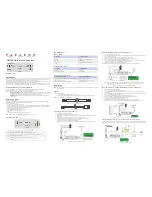
NMRA
Wire
In train
Description
plug in No.
colour
Decoder
1
Orange
J7
Motor right
2
Yellow
J4
Rear Light
Function 2
3
Green
J9
Function 3
4
Black
J2
Left Rail
5
Grey
J3
Motor Left
6
White
J5
Front Light
Function 1
7
Blue
J6
Common (V+)
8
Red
J8
Right Rail
9 Flying
Purple
J1
Function 4
Lead
Maximum current carrying capacity of the decoder in sum
1 A
Rated continuous current output in sum
500mA
Continuous motor output current
500mA
Function output current
100mA each
Address
CV 1
1-127
CV 17-18
1-9999
Speed Steps (Selectable)
14, 28, 128
Dimensions
17 x 10 x 3.5mm
Features
• Control of the motor’s rotational speed (load
compensation)
• Acceleration and deceleration separately adjustable
• Selectable for operation with 14, 28, 128 speed steps
• Programming on main track
• Four On/Off function outputs. Two of the function
outputs are dedicated for the head / tail lights.
• Operation on standard DC systems (analogue
operation) possible
• Motor overload current protection
• With NMRA RP-9.1.1 / NEW652 medium plug
Normal operation
Technical Specification
Connections
Specifications
List of supported CVs
All the CVs shown can be programmed in Operating Mode, Register
CV Mode, Paged CV Mode and Direct CV Mode.
All the CVs shown can be interrogated in all service modes.
The Hornby Decoder supports programming on the Main.
Some advice on the current draw of the decoder output:
The current for all the decoder outputs is supplied by an internal
rectifier with a maximum current of 1 Amp and the rated continuous
current is 500mA. The sum of all currents to the motor and the
function outputs should not exceed 500mA at normal continuous
operation and cannot exceed 1 Amp. If the motor current exceeds
500mA the decoder will automatically cut off power to the motor.
Function outputs are not protected. Each individual output can only
draw up to it’s limit.
For example if a motor requires as much as 400mA continuously then
the function outputs combined should not exceed 100mA.
Therefore, if the directional headlights require 50mA then the load
Function 1 and Function 2 should not exceed 50mA.
For more information visit:
www.
hornby
.com
CV Name
CV
Default
Description
Value
Primary Address
1
3
Bits 0-6 contain an address with a value between 1 and 127. Bit seven must have a value of "0". If the value of
Configuration Variable #1 is "00000000" then the decoder will go out of NMRA digital mode and convert to the
alternate power source as defined by Configuration Variable #12.
Acceleration Rate
3
5
Determines the decoder's acceleration rate.The formula for the acceleration rate shall be equal to (the contents
of CV#3*.896) /(number of speed steps in use).
Deceleration Rate
4
5
Determines a decoders braking rate.
Manufacturer Version No.
7
13
Manufacturer defined version info
Manufacturers ID
8
48
Values assigned by NMRA
EMF Feedback Cutout
10
128
Contains a value between 1 and 128 that indicates the speed step above which the back EMF motor control cuts off.
Extended Address
17-18
The Extended Address is the locomotives address when the decoder is set up for extended addressing (indicated
by a value of "1" in bit location 5 of CV#29). CV#17 contains the most significant bits of the two byte address
and must have a value between 11000000 and 11100111, inclusive, in order for this two byte address to be valid.
CV 18 contains the least significant bits of the address and may contain any value.
Configuration Data #1
29
Decoder Configuration byte 1
Bit 0 = Locomotive Direction: "0" = normal, "1" = reversed.This bit controls the locomotive's forward and backward
direction in digital mode only. Directional sensitive functions, such as headlights (FL and FR), will also be reversed
so that they line up with the locomotive's new forward direction.
Bit 1 = FL location: "0" = bit 4 in Speed and Direction instructions control FL, "1" = bit 4 in function group one
instruction controls FL.
Bit 2 = Power Source Conversion: "0" = NMRA Digital Only, "1" = Power Source Conversion Enabled.
Bit 5 = "0" = one byte addressing, "1" = two byte addressing (also known as extended addressing).
























